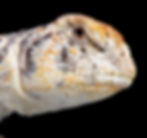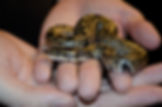Please call ahead to schedule an appointment. Occasionally, there are longer wait times when our staff is dealing with a medical emergency. We appreciate your patience. Book your appointment here >

Tortoise Care Guide
Tortoise Care Tips: Everything You Need To Know About Your Pet Tortoise
For reptile lovers, tortoises are fascinating pets. In the wild, they are mostly land-dwellers, who naturally live near bodies of water. Big or small (and some are quite big), tortoises are a life commitment as some types of tortoises can live for more than 80 years in captivity.

The Natural History of Tortoises
The Russian Tortoise (AKA Horsfield’s, Four-Toed, Steppe, Central Asian, or Afghan):
Originating from East Iran, Central Asia, parts of China, and Russia. Russian tortoises in the wild live in open landscapes near vegetation and a water source. These areas tend to experience extreme weather. Due to the weather, they are naturally active for only three to five months of the year. They spend the hot summer months inactive, and they hibernate during the freezing winter months. In captivity, they can be active for almost the entire year.
Russian tortoises tend to be a small species. They are fully grown at around 20-30 years old, with the males measuring five to six inches long, and females about seven to eight inches long. They reach sexual maturity at age ten. In captivity, they have a life expectancy of 40-60 years.
The African or Sulcata Tortoise:
Native to the deserts of sub-Saharan Africa, the African Tortoise is the third largest tortoise in the world. They are vegetarians and have evolved to survive on small amounts of food and water.
Sulcata tortoises sexually mature at five to eight years old. A typical adult male tortoise measures about 24-30 inches long, and weighs in at 70-120 pounds. Female tortoises are usually 20-24 inches long and weigh 65-75 pounds. In captivity, the African Tortoise can live 80 years or more.
The Red-Footed Tortoise:
These tortoises are found all over South America. A medium-sized tortoise, they have learned to adapt to many different kinds of environments. They come in a variety of colors and patterns, which vary based on their geographical origins. The most popular one is the “cherry-head” from Argentina. This species of tortoise is currently protected from being imported internationally, which unfortunately has led to smuggling.
Red-footed tortoises sexually mature around 8-12 years. Adults measure 8-14 inches long. In captivity, red-footed tortoises can live between 55-65 years.
Breeds of Tortoises
There are three popular breeds of tortoises that are often kept as pets: the Russian Tortoise, the African or Sulcata Tortoise, and the Red-Footed Tortoise. Each of them originates from a different part of the world, and while they have a lot of similarities, there are important differences to know about how to care for them
Is it a Girl or a Boy? Figuring Out the Sex of Your Pet Tortoise
When tortoises are young and quite small, it is difficult to tell males and females apart. Tortoises begin to show clear signs of their sex around ages three or four. In all species, male tortoises tend to be larger than females and have longer tails. If you want to find out the sex of your pet tortoise, check with your exotic vet.


How to Care for Your Pet Tortoise
The first step after acquiring your tortoise is to take him or her to a veterinarian who specializes in exotics and has experience with tortoises. The vet will perform a general check-up and usually recommend a fecal exam and blood work. This is extremely important since reptiles oftentimes carry disease, especially if they have been illegally smuggled from a foreign country.
Here are signs to check for when you bring your new tortoise home:
-
Legs should be strong and muscular. The tortoise must be able to lift itself from the ground.
-
Their vent, skin, scales, and beak should be clean.
-
Shells should be smooth and firm. Look for injuries, damage, or pyramiding of scutes.
-
Eyes should be clear, bright, and free from discharge. The nose should also be free of discharge or foreign objects.
-
They should not be breathing with an open mouth.
-
A healthy tortoise is alert and responsive.
Your Tortoise Enclosure
The ideal enclosure for your pet depends on the type of tortoise you have. Adult Sulcata tortoises need much larger enclosures, with a minimum recommended size of 5x5 feet or larger depending on the size of your tortoise. For other tortoises, you can follow the rule of three times the length of your pet tortoise’s shell, by four times the width.
Make sure there is a wading dish and basking area within the enclosure. Placing rough-sided paver stones and flat rocks near feeding and basking areas of the enclosure encourages natural wear down of nails and beaks.
Enclosures can be placed either inside or outside, which is dependent on certain humidity and temperatures in the area and should be discussed with your exotics vet.
NOTE: Aquarium tanks are not recommended for tortoises. They tend to be too tall and suffocate the airflow. Proper ventilation is extremely important for your tortoise’s enclosure.
Indoor Housing
Tortoises love the sun and need at least 10-12 hours a day of exposure to sunlight, or artificial UVB light, as well as a basking spot.
Things to avoid in indoor housing:
-
Unsupervised roaming outside of the enclosure.
-
Direct contact with heating sources.
-
Keep them away from cat and dog food, as well as insects, or toxic sprays.
Outdoor Housing
Housing your tortoise outdoors can work if you are able to provide the right climate. The enclosure must be fully prepared beforehand. If there is extreme weather where you live, prepare an indoor area where you can put your tortoise when needed.
Outdoor enclosures must protect the tortoise from predators (cats, dogs, foxes, etc…), and keep them from escaping. Keep in mind that tortoises can both climb and dig. The substrate (bedding, ground) cannot stay damp and must be protected from flooding. Any plants in or near the enclosure must be safe for your tortoise to eat. The area should be warm, dry, have exposure to natural sunlight, and a sheltered area where they can hide from the elements.
Substrate
The bottom of the enclosure should be covered with tortoise substrate. The substrate must help maintain a balance of wet/humidity and dryness. A substrate that is constantly damp can cause mold or bacteria growth, which is likely to cause illness and infection. You can purchase tortoise substrate at the pet shop, but there are other options that should be discussed with your exotics vet.
Important: If you choose to keep your tortoise on grass, make sure that it is pesticide-free.
Why Your Tortoise Needs a Hide Box
Tortoises need a closed box within their enclosure that they can easily enter. Tortoises use these boxes as a shelter to hide in, especially at night. This gives them a feeling of safety and decreases stress.
Providing the Right Climate for Your Tortoise
Temperature and Humidity
All tortoises need a temperature gradient within their enclosures as well as a spot for basking, and either UVB exposure or, ideally, exposure to direct sunlight.
You will need to monitor the temperature to make sure your tortoise won’t overheat. It’s important to install at least two thermometers within the enclosure, one measuring the warm, sunny area of the enclosure and the second measuring the cooler part. They should be placed at the height of the tortoise, and not above or in close proximity to the heat source.
Lighting
All tortoises need either direct sunlight or UVB radiation, both for basking and to help them absorb calcium from their diet. If your tortoise is kept outdoors, they should have a space where they can receive direct sunlight and a space where they can seek shelter from the sun.
If you keep them indoors, you will need to install an appropriate UVB light which should be changed regularly.
Tortoise Diet and Nutrition
What Do Tortoises Eat and Drink?
A healthy tortoise diet includes a variety of vegetables and some fruits for treats (no more than 5% of their diet).
Supplements are not necessary. You should consult your tortoise veterinarian before giving them.
Water
Regardless of what species you have, your tortoise should always have fresh water available. The water must be replaced daily since tortoises tend to defecate in their water sources. Disinfecting your tortoise’s water dish should be done regularly to prevent bacterial build-up and/or illness.
The water should be supplied in a dish that is big enough for the tortoise to soak in, deep enough for them to sit inside with their legs tucked right up to their nostrils, yet shallow enough that they can easily exit the water.
Tortoises, like most reptiles, carry Salmonella bacteria in their intestinal tract, which comes out in their feces. For your own safety, wash your hands and the cage regularly. Keep this in mind and take precautions, especially with young children or around anyone with a compromised immune system.


Tortoise Behavior
-
Sulcata Tortoises are known to be outgoing and active, which is why they are a popular choice of pet. They are very small when they are first born but they grow large quite quickly. They enjoy digging and are good at it!
-
Red-Footed Tortoises can learn to identify their caregivers. If handled regularly and gently, they can become calm and interactive. They are fast learners and can recognize and understand their surroundings. Solo animals, do well on their own and prefer not to socialize with other tortoises.
-
Russian Tortoises are known to be sturdy and simple. They can be very personable and curious
Hibernation
Hibernation is not necessary for captive tortoises. Before you help your tortoise hibernate, please consult your veterinarian. An ill tortoise that goes into hibernation could prove to be fatal.
Medical Care for Your Pet Tortoise
Most medical conditions are a result of poor living situations and wrongful care, which can easily be avoided. You should schedule a regular checkup with your vet so that you can notice early signs of disease or parasites.
The most common diseases in tortoises are:
-
Parasites
-
Trauma
-
Respiratory infections
-
Shell rot
-
Dehydration
-
Metabolic disorders
-
Obesity
-
Malnutrition
-
Wounds and burns
Here are some easy things you should and should not do to ensure smooth sailing with your tortoise:
Do not:
-
Purchase a wild-caught tortoise. Only purchase a tortoise from a known, certified breeder.
-
House your tortoise with other reptiles or tortoises.
-
Leave any sharp edges in your tortoise’s enclosure. For example, avoid gravel, walnut shells, and cedar chips; These can be swallowed and cause internal damage.
-
Place heating or light sources within your tortoise’s direct reach.
-
Allow your tortoise to roam your house unsupervised.
-
Expose your tortoise to your cats or dogs. Protect them from predators.
-
Give them dog or cat food.
-
Let small children or inexperienced people handle your pet tortoise.
-
Let them near pesticides.
Do:
-
Check the enclosure’s temperatures each day, both during the day and at night.
-
Monitor their food intake, and feed them a quality, varied diet.
-
Protect them from predators. If they live outdoors, supply them with protection from the elements.
-
Provide natural sunlight when possible.
How Do I Know If My Tortoise is Sick?
Check on your tortoise daily to monitor physical changes. If you see one of these symptoms, do not hesitate to contact your exotics vet!
-
Shell pyramiding
-
Soft shell
-
Abscesses
-
Injuries
-
Ticks
-
Diarrhea
Tortoise Emergencies:
-
Dehydration
-
Respiratory infections
-
Kidney disease
-
Bladder stones
-
Shell infections
-
Intestinal parasites











